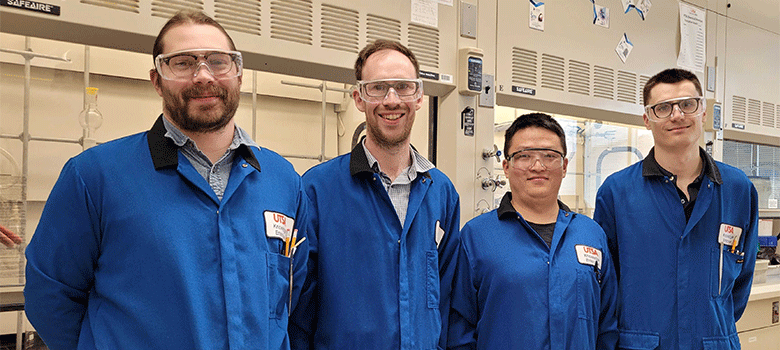
Maksym Pavlenko and Jitao Xu prepare to work under the fume hood in the Sandford Lab at UTSA.
MARCH 6, 2025 — A UTSA chemist is pioneering a novel approach to drug discovery by using catalysts that are triggered by light. This innovative approach, paired with advanced automated lab techniques, could lead to the next generation of antibiotics.
Christopher Sandford, assistant professor of chemistry in the UTSA College of Sciences, is using $1.8 million in National Institutes of Health (NIH) funding for the project, entitled, “Switchable Organometallic Catalyst for Organic Reaction Development.” His work focuses on using light to activate metal-based catalysts, which could lead to faster and more effective drug development.
Antibiotic resistance is a nationally growing crisis. According to the U.S. Centers for Disease Control and Prevention, over 2.8 million antimicrobial-resistant infections occur in the United States each year, with more than 35,000 people dying as a result.
“This is an opportunity to design and build a new generation of antibiotics,” Sandford said. “Our goal is to develop new technologies that can improve the selectivity afforded in the automated synthesis of libraries of molecules that can be used in multiple areas of medicine.”

From left to right: Jacob Dalton, postdoctoral researcher; Christopher Sandford, assistant professor of chemistry; Jitao Xu, postdoctoral researcher; and Maksym Pavlenko, graduate student, are members of the Sandford Lab focusing on the design of new catalytic reactions.
Chemists often use an advanced laboratory technique called automated parallel synthesis, which allows them to create and test many different variations of a molecule at once. However, one challenge in using this technique is being able to precisely control these chemical reactions to ensure modifications occur only within targeted areas without impacting the rest of the molecule.
Sandford’s research is addressing this challenge by developing a specialized catalyst that responds to different wavelengths of visible and ultraviolet light. This would allow researchers to trigger specific chemical transformations at the molecular level with unprecedented precision, which would streamline the process of drug discovery.
Beyond the impact in developing new medicines, the project will provide career-readiness opportunities for UTSA students. Undergraduate and graduate students will receive hands-on training and learn advanced laboratory techniques that will prepare them for careers in research and drug discovery.
Sandford earned his Ph.D. in Synthetic Organic Chemistry from the University of Bristol and his MChem in Chemistry from the University of Oxford. He oversees the Sandford Lab at UTSA, which focuses its research on the design of new catalytic reactions and the understanding of their underlying reaction mechanisms. The lab’s work spans from physical organic chemistry to all aspects of modern synthetic organic chemistry, with the goal of creating new reaction methodologies to address challenges in medicine and sustainability.
UTSA Today is produced by University Communications and Marketing, the official news source of The University of Texas at San Antonio. Send your feedback to news@utsa.edu. Keep up-to-date on UTSA news by visiting UTSA Today. Connect with UTSA online at Facebook, Twitter, Youtube and Instagram.
Move In To COLFA is strongly recommended for new students in COLFA. It gives you the chance to learn about the Student Success Center, campus resources and meet new friends!
Academic Classroom: Lecture Hall (MH 2.01.10,) McKinney Humanities BldgWe invite you to join us for Birds Up! Downtown, an exciting welcome back event designed to connect students with the different departments at the Downtown Campus. Students will have the opportunity to learn about some of the departments on campus, gain access to different resources, and collect some giveaways!
Bill Miller PlazaCome and celebrate this year's homecoming at the Downtown Campus with food, games, giveaways, music, and more. We look forward to seeing your Roadrunner Spirit!
Bill Miller PlazaThe University of Texas at San Antonio is dedicated to the advancement of knowledge through research and discovery, teaching and learning, community engagement and public service. As an institution of access and excellence, UTSA embraces multicultural traditions and serves as a center for intellectual and creative resources as well as a catalyst for socioeconomic development and the commercialization of intellectual property - for Texas, the nation and the world.
To be a premier public research university, providing access to educational excellence and preparing citizen leaders for the global environment.
We encourage an environment of dialogue and discovery, where integrity, excellence, respect, collaboration and innovation are fostered.